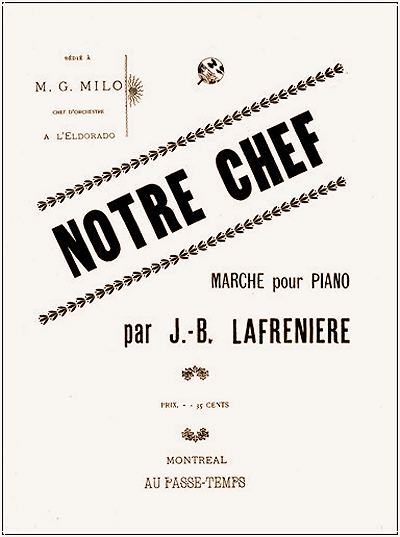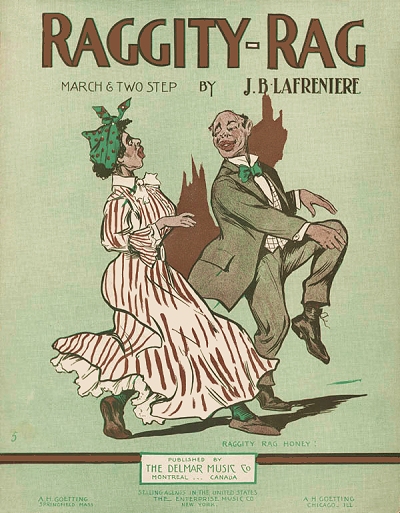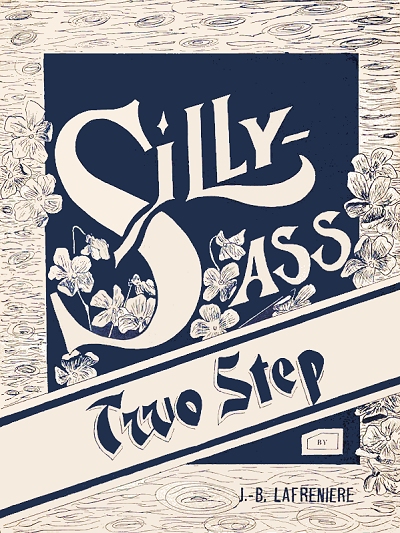Lauded upon his death as the "National Strauss of Canada," Jean-Baptiste Lafrenière was perhaps the first composer from that country to embrace ragtime while never straying far from the beloved waltzes he so capably turned out. He was also the first known pianist to perform ragtime in Montréal, Québec, and among the first to accompany early films in theaters as well.  While less known in the United States, indeed hardly known at all until pianist Mimi Blais started playing his works at American ragtime festivals, he was well regarded in Québec, although largely for his non-ragtime works.
While less known in the United States, indeed hardly known at all until pianist Mimi Blais started playing his works at American ragtime festivals, he was well regarded in Québec, although largely for his non-ragtime works.
 While less known in the United States, indeed hardly known at all until pianist Mimi Blais started playing his works at American ragtime festivals, he was well regarded in Québec, although largely for his non-ragtime works.
While less known in the United States, indeed hardly known at all until pianist Mimi Blais started playing his works at American ragtime festivals, he was well regarded in Québec, although largely for his non-ragtime works. Lafrenière was one of eight children born to Antoine-Théophile Lafrenière and Cléophas-Zoé Giroux in the village of Maskinongé in Quebec, Canada, around 90 kilometers northeast of Montréal. He was named for Saint Jean-Baptiste in recognition of his being born one day before the national holiday in honor of that saint. His siblings included Maria (1858), Henri (1865), Corine (1867), Elmina (1868), Maria (1871), Adrien (1873) and Yvonne (1876). In 1878 the family moved to Montréal where he spent much of his youth. They appear in Montreal City in the 1881 Canadian census in the St. Louis Ward. The Lafrenière family eventually moved to Louiseville, about 10 kilometers from his birthplace, in 1885. At age 13 he was put into a deep study of music education, learning piano, organ, violin, cornet and music theory at the College Saint-Joseph de Berthierville just to the northeast of Montréal. When he graduated in 1892, Jean-Baptiste was well-equipped for a career in music, yet immediately went to Laval University to pursue other interests. Within a year he was certain that music was his passion and desire, and dropped out of the university to pursue it.
Going back to Louiseville, Jean-Baptiste found work as the music director and organist in a local church parish. It was there he wrote his first arrangements and compositions for piano and orchestra, in addition to giving lessons in piano and violin. He also wrote several religious works there, of which some are known but all are lost. After two years he moved to Joliette to a much larger congregation, The Church of St. Charles Borromeo (Joliette Cathedral after 1904). It was there that he not only directed the choir and orchestra, but became the organist and chapel master, in addition to teaching piano, violin, clarinet and cornet. At some point there were some differences between the young musician and the parish, and a rival music director helped to expel him from the job in early 1898. Jean-Baptiste decided to strike out for Montréal where there was more opportunity, and perhaps less in the way of constraints. During this period the composer got married. He is shown in the 1901 census in Sorel, northeast of Montréal, married to Caroline Lafrenière. The occupation listed is unclear.
and a rival music director helped to expel him from the job in early 1898. Jean-Baptiste decided to strike out for Montréal where there was more opportunity, and perhaps less in the way of constraints. During this period the composer got married. He is shown in the 1901 census in Sorel, northeast of Montréal, married to Caroline Lafrenière. The occupation listed is unclear.
 and a rival music director helped to expel him from the job in early 1898. Jean-Baptiste decided to strike out for Montréal where there was more opportunity, and perhaps less in the way of constraints. During this period the composer got married. He is shown in the 1901 census in Sorel, northeast of Montréal, married to Caroline Lafrenière. The occupation listed is unclear.
and a rival music director helped to expel him from the job in early 1898. Jean-Baptiste decided to strike out for Montréal where there was more opportunity, and perhaps less in the way of constraints. During this period the composer got married. He is shown in the 1901 census in Sorel, northeast of Montréal, married to Caroline Lafrenière. The occupation listed is unclear.After teaching lessons and playing here and there, Lafrenière got a position as a pianist in the Eldorado Café-Concert Orchestra. This lasted for two years until a long-ignored bylaw was suddenly enforced, causing the closure of all of the Café-Concert halls in Montréal in 1901. Forced to find other work, he started playing as an accompanist in a number of Montréal theaters, including the National Théâtre, French Théâtre (later The Metropolis) and Théâtre des Nouveautés. In the latter he collaborated with author/director Léo-Ernest Ouimet writing arrangements for the resident singing group. While working in these theaters he became familiar with both Canadian and American popular music, and began to write compositions in these styles, including marches and two-steps, although he had already composed at least two marches prior to this time. Jean-Baptiste soon found out that he could make some of his best music in waltzes, salon pieces and similar classical forms. The composer even tried his hand at the occasional chanson (song) over the next decade with a number of different lyricists. To sustain a viable income, Lafrenière also taught music from his home on Sanguinet Street. At some point over the next year he was either widowed or divorced. A search for this information is still underway.
On August 25, 1903, Jean-Baptiste married Victoria Danis, who like him had been previously married, then sadly widowed one year prior, having had no children. That soon changed as the couple welcomed Jeannette in April of 1903 and Madeleine in May of 1905. A third child was born in May of 1910, Edmour Denis. Jean-Baptiste gave birth to something else in 1907, however; French-Canadian Ragtime. It was then he published Raggity Rag, very likely making him the first pianist to perform AND compose ragtime in Montréal, if not Canada. This was followed by Silly-âss, a rag two-step. Another fine composition from this busy year was his haunting Valse Miroir (Mirror Waltz), one of the finest of his career. The cover of that work features his two small daughters reflected in a mirror. Most of his works were published by J. E. Belair in his monthly revue Le Passe-Temps, but a few, including Raggity Rag, were formally published as well. There was also a grand overture composed for orchestra, almost certainly for one of the theaters he was working in, which remains unpublished today.
but a few, including Raggity Rag, were formally published as well. There was also a grand overture composed for orchestra, almost certainly for one of the theaters he was working in, which remains unpublished today.
 but a few, including Raggity Rag, were formally published as well. There was also a grand overture composed for orchestra, almost certainly for one of the theaters he was working in, which remains unpublished today.
but a few, including Raggity Rag, were formally published as well. There was also a grand overture composed for orchestra, almost certainly for one of the theaters he was working in, which remains unpublished today.Having become fairly well known for both his compositions and his organ playing, the next logical step in Lafrenière's career started in March, 1909, when he was employed to play in Montréal's first cinema, La Quimetoscope. For around two years Jean-Baptiste brought many of the early short films to life with magnificent accompaniments, helping to spread knowledge of both his music and his playing ability. However, in 1911 he contracted tuberculosis, forcing him to quit the demands of daily performance and teaching on the side. The family appears in the 1911 census, comprised of Jean-Baptiste, Victoria, Jeannette, Madeleine and Edmour. He listed himself as a musician [musicien] and composer [compositeur].
For the next several months the Lafrenière family lived on the meager income from his publications in print. He finally died at the beginning of 1912, leaving behind a handful of unpublished works (some of which were later put into print), a widow, three orphans, and a grieving public. He was buried in the Cˆte-des-Neiges cemetery in Montreal. Edmour Denis died just three weeks later in late January at around 20 months old, also from tuberculosis. Victoria died soon after, although her family had her buried elsewhere. The two orphans were quickly put into the care of Victoria's sister Stella Danis and her husband, surgeon Jules Joseph Hamelin, M.D..
While it has taken the better part of a century, the music of Jean-Baptiste Lafrenière has become performed and appreciated increasingly in both Canada and the United States. His works are frequently heard on Radio-Traditional Montréal, and Montréal pianist Mimi Blais has not only researched and recorded many of his piano pieces, but has even brought him back to life in her performances as well. Along to Willie Eckstein, who continued in some ways in Lafrenière's footsteps, and a few other pianists born "north of the border," Canada has been able to share a ragtime legacy with the United States.
Some very useful information that brought some clarity this article was provided by Patti Lucas, great granddaughter of Lafrenière. Among those who have done some good research on Lafrenière are historian Clément Plante and contemporary French-Canadian classical and ragtime pianist extraordinaire Mimi Blais, who not only has embraced and recorded a large number of his works, and at times has been known to suspiciously resemble the long-departed composer/pianist when she appears on stage wearing his bushy moustache. To review or purchase her recordings of his work, please visit her at www.mimiblais.com.
The works of Lafrenière are also available to view or print out thanks to the thorough diligence of Canadian music historian Ted Tjaden on his Ragtime Piano site, www.ragtimepiano.ca.
 Ragtime and March Compositions
Ragtime and March Compositions